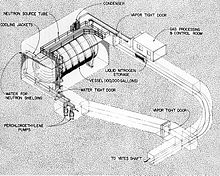
Back تجربة هومستاك Arabic Homestake-Experiment German Expérience Homestake French Esperimento Homestake Italian Хоумстејк експеримент Macedonian Homestake deneyi Turkish


The Homestake experiment (sometimes referred to as the Davis experiment or Solar Neutrino Experiment and in original literature called Brookhaven Solar Neutrino Experiment or Brookhaven 37Cl (Chlorine) Experiment)[1] was an experiment headed by astrophysicists Raymond Davis, Jr. and John N. Bahcall in the late 1960s. Its purpose was to collect and count neutrinos emitted by nuclear fusion taking place in the Sun. Bahcall performed the theoretical calculations and Davis designed the experiment. After Bahcall calculated the rate at which the detector should capture neutrinos, Davis's experiment turned up only one third of this figure. The experiment was the first to successfully detect and count solar neutrinos, and the discrepancy in results created the solar neutrino problem. The experiment operated continuously from 1970 until 1994. The University of Pennsylvania took it over in 1984. The discrepancy between the predicted and measured rates of neutrino detection was later found to be due to neutrino "flavour" oscillations.[2]
- ^ Bahcall, J. N.; Davis Jr, R. (1976). "Solar Neutrinos: A Scientific Puzzle | Science". Science. 191 (4224): 264–267. doi:10.1126/science.191.4224.264. PMID 17832133. Archived from the original on 2017-08-15.
- ^ Gonzales-Garcia, M. C. (2003). "Neutrino Masses and Mixing: Evidence and Implications". Reviews of Modern Physics. 75 (2): 345–402. arXiv:hep-ph/0202058. doi:10.1103/revmodphys.75.345. S2CID 119501801.
© MMXXIII Rich X Search. We shall prevail. All rights reserved. Rich X Search